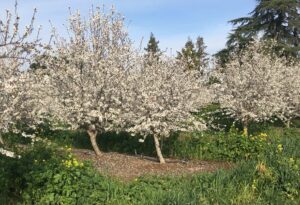
The weather during almond bloom can vary from day-to-day. This creates challenges with farm operations, but also changes how the tree adapts to the weather. Cooler, hotter, or wet weather has significant impacts on the pollination process, fertilization of the ovule, and eventual crop set.
Cooler temperatures aren’t necessarily bad for bloom. Flower development is growing degree day based, meaning that cooler temperatures will slow flower development. Additionally, the viability of the ovule and pollen are longer when temperatures are cooler. This natural response increases the pollination period, and partially explains why crop set is often larger than expected during cooler than desired bloom periods. A video presentation on almond pollination and fertilization can be found here.
Cooler temperatures, however, do impact honeybee activity. Temperatures below 55F (12C) suppress honeybee activity as more bees are required to remain in the hive to keep it warm. This means fewer bees are available to gather pollen and nectar, affecting the rate of the pollination process. If hive temperatures drop too much, the rate of the queen’s egg laying decreases, affecting eventual hive strength. This could be problematic during extended periods of cold temperatures followed by warm temperatures with a fast/short bloom.
The effect of cold temperatures on honeybee activity is why strong hives (8 frames or more) are recommended. Hives with more frames of bees have more bees, which means hive temperatures are higher and more bees can forage. This is often evident on cold mornings, when hive inspections can reveal lower bee activity in weaker hives.
If temperatures are too hot, the bloom period can be rapid. In high temperature years, bloom can finish in 7-10 days. High temperatures also shorten the viability of pollen and the ovule. Bee foraging activity must be able to match the rate of flower opening to maintain high crop yield.
Rainy weather during flowering requires fungicide applications. Although susceptibility to diseases varies by variety, it is generally good practice to consider a fungicide during bloom if multiple days of rain are expected. If conditions are forecasted to be without rain, the bloom time fungicide could be skipped, but it is still strongly encouraged to make a fungicide application at petal fall. More on weather considerations (here) and fungicide selection (here) are linked. Additionally, the 2022 fungicide efficacy document produced by the University of California is linked (here).
The greatest risk during flowering is freezing cold temperatures. Frost risk is always present for almond bloom. As the flower develops, it becomes more susceptible to frost. For example, at pink bud, flowers typically can withstand 26F, while at petal fall this threshold is 29-30F. Flowers tend to tolerate temperatures between 28-30F, but some varieties do have increased or decreased susceptibility. Managing frost within most orchards generally occurs with the application of water, increasing the heat within the orchard. More on that can be found here.
Rarely do farmers experience the perfect weather throughout bloom. Even so, bad weather doesn’t mean bad news, but will require a change in practice to help mitigate the potential risk. Therefore, it is necessary to be aware of the changing weather conditions to properly shift practices to manage potential risks.


Steve House
February 12, 2023Excellent advice and information
Davidd
February 15, 2023Thanks Steve!
David